OUR BLACK ART AND CULTURE IS SUBSTANTIAL
The Summer issue in collaboration with The North Carolina Museum of Art is a glimpse into Black Art and culture in NC.
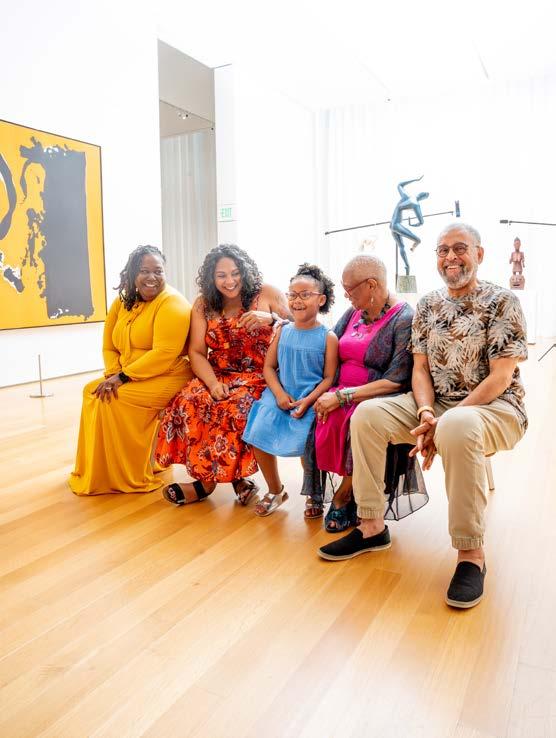
SUMMER
2023

ON THE COVER
A special thank you to North Carolina Poet Laureate Jaki Shelton Green and her


2 Boho-chic fashion
beautiful family.
table of contents
Front Cover left to right: daughter, Eva Green Baysmore, daughter Amina Fisher, granddaughter Fiona Fisher, and husband Abdullateef Fisher.
MAGAZINE SUMMER 23
PRESIDENT & EDITOR-IN-CHIEF
• Greg Hedgepeth
DIRECTOR OF BUSINESS DEVELOPMENT AND STRATEGIC PARTNERSHIPS
• Evelyne Del
NORTH CAROLINA MUSEUM OF ART
DIRECTOR, MARKETING & COMMUNICATIONS
• Lizzie Newton
NORTH CAROLINA MUSEUM OF ART
MARKETING MANAGER

• Okirah Harris
CONTRIBUTING WRITERS
• Joelle Adeleke • Maya Brooks
• Evelyne Del • Marjorie Hodges
• Kimberly Knight
CONTRIBUTING PHOTOGRAPHERS
• Randy Curtis, 8bitcreatives
• Morgan Crutchfield, Morgan Crutchfield Photography
• Arianna Earle
• Sanjé James
• Trey Joyner, TJ Supreme.Media
• Jonathon Leach, ShotsByCash
• Shae Royster
10 10 22 28
06

CARLY JONES
Art Executive and Performing Artist
RICHARD WILSON, JR.
Capturing Memories and Connecting Through Art
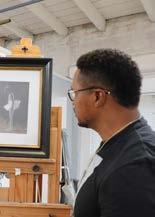
CLARENCE HEYWARD
15 minutes with an artist
JAKI SHELTON GREEN
Words from the Poet Laureate
INSIDE THE ISSUE
14 Aliyah Bonnette
Weaving and painting the Stories of our community
17 Jalen Jackson
The power of nostalgia
36 Linda Shropshire Eudy
18 Randy Rogers
Five Questions with Artist freedom clay
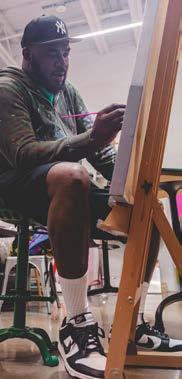
Redefining Art Narratives through Ella West Gallery
40 Pierce Freelon
Leading the Pathway to Afrofuturism
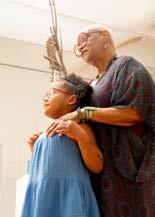
3 28 22
6
editor’s letter
Art has always been a powerful medium for self-expression, cultural preservation, and societal transformation. Throughout history, it has served as a mirror reflecting the diverse experiences and perspectives of different communities. In this letter, I want to emphasize the crucial importance of recognizing and celebrating Black art and Black artists, particularly in the context of North Carolina. North Carolina has a rich cultural heritage, deeply influenced by the African American community that has played an integral role in shaping the state’s history and identity. From the vibrant music of jazz and blues to the captivating literature and poetry, Black artists have made indelible contributions to the artistic landscape of North Carolina. Their creativity and artistic endeavors have not only enriched the cultural fabric of the state but have also provided a platform for telling powerful stories, challenging stereotypes, and fostering dialogue about race, identity, and social justice.
In developing this issue alongside the North Carolina Museum of Art I have witnessed firsthand the talent and artistic brilliance of Black artists, and while recognition and representation have not always been proportionate to their contributions their work is nothing less than Substantial. We must amplify the voices of Black artists and advocate for their rightful place in North Carolina’s cultural narrative.
This issue is dedicated to showcasing and promoting Black artists in North Carolina. Through our platforms, we will continue to feature their work, amplify their voices, and provide a space for dialogue and appreciation.
We encourage our readers to actively seek out and support black artists, attend their exhibitions, purchase their artwork, and engage in thoughtful discussions about their contributions. This is only a glimpse into what was, what is and all that will be.
Greg Hedgepeth
Greg Hedgepeth President & CEO Substantial Media LLC

4
Dear Substantial Magazine Reader:
We believe in the transformative power of art. From the North Carolina Museum of Art’s (NCMA) permanent People’s Collection to our 164-acre Park, Performing Arts programming to educational outreach, our goal as a museum is to create a welcoming experience. A place where all can connect to, engage with, and see themselves in the arts.
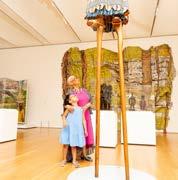
Central to this mission is our support of North Carolina creative communities. The NCMA’s partnership with Substantial Magazine is a small moment to celebrate the incredible contributions and dynamic conversations of Black art and artists currently occurring across our state. Our hope is you will discover someone or something new on the following pages. An artwork or artist, gallery or organization that brings you joy and invites you to become an advocate for the arts.
These 50 pages, admittedly, are only able to reflect a selection of the Black artists, galleries, and arts organizations in North Carolina. Which is why we hope you will share your arts story on page 47, so we can continue this conversation.


Thank you to Substantial Media President and Founder, Greg Hedgepeth; Director of Strategic Partnerships, Evelyne Del; and the Substantial team for inviting the NCMA to be a part of this project. We are proud to support the first Substantial arts issue.

Sincerely,
Lizzie Newton Director, Marketing & Communications at the North Carolina Museum of Art
5
Carly JONES
ARTS EXECUTIVE AND PERFORMING ARTIST
Art has the remarkable ability to reflect and shape our unique society. It acts as a powerful medium for cultural expression and social change in the Black community, and creates a connection to our shared journey of struggle, resilience, and vitality. In the heart of Raleigh, North Carolina, ArtSpace has become a landmark for creativity, showcasing the diverse and vibrant world of Black art. Artspace serves as a unique hub for artists, offering them a space to create, exhibit, and connect with fellow artists and art enthusiasts. What sets this space apart is not only its physical presence as an eclectic community of visual artists under one roof, but also its dedication to nurturing creativity and championing the transformative power of art.

6
At the helm of this visual art nonprofit is Carly Jones, an accomplished artist and creative CEO of Artspace, whose journey exemplifies a commitment to promoting Black art and fostering a thriving artistic community. As an artist herself, Jones has a deep-rooted passion for showcasing the richness and diversity of Black art. Her journey as CEO of Artspace is a testament to her unwavering commitment to creating an inclusive platform that celebrates and elevates Black artists in North Carolina. Substantial takes a peek into the world of Carly Jones and the thriving artist community at Artspace.
Tell us about Carly Jones.
My name is Carly Jones, and I was born and raised in Raleigh, North Carolina. I am an Arts Executive and CEO of Artspace in downtown Raleigh. I’m also a performing artist myself, and I love what I do. And I love all of the connections that I get to make every day with artists.
Artspace is very unique. It is a visual art nonprofit located in the very heart of Raleigh, and the City Market area. And we have the largest community of visual artists under one roof, creating together here in this space - sculptors, painters, textile artists, you name it. We also have three gallery spaces that are open to the public. Those galleries have art from all over the country and the region, rotated regularly. And then we also have arts education for all ages.
I actually went to camp here as a kid. So that’s how long we’ve been doing arts education. So all of that intersects really beautifully, because children and youth can come and actually learn more about art and the creative process and explore that and meet actual artists that are here living and working in our communities. So it’s a really unique and special place.
Talk to us about the significance of the Artspace and being here.
We love our building. It is a large historic building in a historic area of Raleigh called City Market. It actually was originally the city livery, which is where the horses were kept back in the day. So it was built in 1911. And then it eventually became the Ford Sanders automobile dealership for a while in the 50s. And then later on in the 1980s, it became art space, it was renovated into this, this space that we now know and love.
That’s so awesome. It’s important to know that history because it talks about the foundation of how long you all have been around. You mentioned going to art camp as a kid. When did you know, Or when did you develop a passion for the arts?
The arts were really important to me as an outlet, growing up as a child. I grew up in a biracial household, in the 80s, and 90s. There weren’t a lot of kids like me back in the day. And I found a real creative, safe space on stage singing, and creating and being able to express and really use my own voice at art camp and in classes. So that was really important for me, growing up and becoming the woman that I am today to really build the confidence that I now have, and really know who I am, and learn more about other people and other perspectives.
You know, I think that art is a powerful tool that connects us. I think, oftentimes folks believe that art is just entertainment
or fluff, and it can be an escape from the real world. Art can be an escape, it can be beautiful. It can also be a powerful tool to amplify voices. Art can bring people together and also get us through those very important conversations and create empathy so that we can understand one another more. I noticed that at a young age, the power in the arts- that it could not only be something fun and exciting, but also a very powerful tool to bring communities together.
Wow. And now fast forward. You’re now the CEO of the Artspace where you went as a kid. Talk to me about your journey to this point. Did you think it would come to this where you are now? It’s a full circle moment for sure. There is no blueprint for a career in the Arts. I think that is what is the most exciting and also challenging part of working within the arts. I did not have a goal to be the CEO of Artspace. When I was growing up, I just knew that I wanted art to be a part of my life. I knew that I wanted to make sure that art was a part of other people’s lives. Arts Access was really important to me, and I learned arts administration and arts management, and actually went to school on a music scholarship. And then I ended up also getting a Major in Arts Administration, learning the business behind the Arts. So I’ve really been able to use that on the funder side when I worked at the North Carolina Arts Council, and then also on this nonprofit side as well. And I think that is a very useful tool for any artist to have- to know about grant writing, to know about marketing, to know about management, and these institutions and these nonprofits that are kind of this thread throughout our art sector.
So yes, my journey to becoming the CEO of Artspace has been interesting, I have really seen all perspectives of arts administration and arts management. I have seen art space through the eyes of a young camper here, I’ve seen art space through the eyes of a funder at the North Carolina Arts Council, and I’ve seen Artspace through the eyes of being on staff here, and also just being in this community. So all of those perspectives are a part of the work that I do here.
Talk to me for just a moment about how Artspace is helping young artists further cultivate their talents and providing them with opportunities to share their work?
Making sure that art is accessible to all people is very important to us. Our mission at Artspace is to inspire positive community impact through art. And we have residencies for emerging artists. We actually have two North Carolina emerging artists and residents here and they have a studio for free for a whole year to get to be a part of our arts community. And then at the end of the residency, we have an exhibition at one of our gallery spaces showcasing their work. We also have a universal access residency, which goes towards artists from the disability community. And we have our newest residency, our HBCU artists and residents, which goes towards an incredible artist that comes from one
7
of our many North Carolina HBCUs. They also are going to be with us for a whole year with an exhibition at the end of the year. Our inaugural artist is Jalen Jackson this year who’s an incredible painter. We also have workshops for young artists about “what does it take to be an artist”, and all of the tools that we need to be able to have a career in the arts. So we want to be a hub not only for people to come and explore art, but also a resource for artists to come together and connect and talk about what’s current in our art sector. And then, of course, we have our arts education.
I mentioned camp earlier; We have camp and classes for young children, but we also have very advanced classes for adults as well. So any level, any age, can come here and learn and explore their creative process. We are very much about making sure that the veil is pulled away from the arts, and it doesn’t have to be mysterious. We want folks to be exposed to the creative process and explore their own creative processes here at Artspace.
So, let’s talk about the executive side of things for just a moment. There may be some young artists that are going to read this feature, and wonder how they get their art commissioned or featured in a gallery. Could you just maybe talk very briefly about the process. Sure, we have a very equitable process on how we choose our artists for our opportunities. Every year we’ll have an artist call, meaning we’ll publicize on our website, and through newsletters and with our partners that we have artist opportunities. And then artists can apply for residencies, they can apply for exhibition opportunities. And then we have what we call a panel process. So every year we come together, and there are a couple of folks on our staff, our amazing team here at Artspace, and we also bring in artists from the communitydifferent ones every year. We make sure there are people from all perspectives, all cultural backgrounds, on our panels, so that we have a fair and equitable process on how to choose artists or artists opportunities. So any young person that’s out there that really wants to be a part of this scene, or learn more or get opportunities, I welcome them to come to Artspace and check it out. Another great thing to do, even if you’re a little too intimidated to apply just yet, is to just come to Artspace on First Fridays of every month. We have extended hours from 6 to 10, and all the artists are here in their studios. It’s free, it’s open to the public, and folks from all over can come here for live music, check out our exhibitions, and talk to other artists here in the space.
Where do you get your creative inspiration?
I get my inspiration from my community. I love people. I love getting to know people and getting to know what makes them tick. That’s where I get most of my inspiration—real life and real people that are in my life.
Growing up, who was your favorite artist?
My favorite artist was Audra McDonald, because I was very into singing and Broadway. She’s not a visual artist, but that’s probably who I was most obsessed with. She has the most Tonys of anyone.
What’s one project you’re most proud of?
My work in collaboration with the African American Heritage commission. When I was at the North Carolina Arts Council, I worked with my colleagues to preserve the home of Nina Simone, which is in Tryon, North Carolina. It was a part of a much larger effort to do that. But I was able to bring in artists as a part of that work.
I love her quote,”An artist’s duty is to reflect the times.” That is what I go by, and there’s a lot of pressure for some people. But for me, that means a lot.
Have you ever had a bad project? And if so, would you learn from it?
Yes, I have had bad projects. I have learned that it is important, if I’m going to personally work on a project as an artist, that I really love the work and I love who I’m working with. I think that sometimes as artists, we all have to make a decision. Am I doing this because I know that this is going to stretch me artistically or just because I need the job? And that is a hard struggle to work with every day. So I think as an artist, I have worked on some not so great projects with folks that don’t share the same mission and vision.
If you could tell your younger self, anything, what would it be?
I would tell myself as a young girl, it’s going to be alright. It’s okay that there’s not a blueprint. Lean into your talents. Lean into your dreams. I know that sounds corny, but it’s true. It will all work out. Nothing is permanent, and it might be hard right now. But if you just keep leaning into your talents and leaning into your dreams, then everything eventually will work out. It may not work out the way that you actually sketched it out to be. But it’ll work out in a whole other way that you could only dream about.
Artspace is supported by the North Carolina Arts Council, a division of the Department of Natural and Cultural Resources; the United Arts Council of Raleigh + Wake County; and funded in part by the City of Raleigh based on recommendations of the Raleigh Arts Commission.

Follow the Artspace on IG @artspacenc
VISIT: ARTSPACENC.ORG
8
Investing in Black Artists: Capitalizing on a Growing Market
The art world has seen a significant shift in recent years, with increased attention being given to Black American artists and their valuable contributions. The market for artwork by Black American artists has experienced substantial growth, indicating a potential opportunity for investors. However, despite notable progress, the market remains relatively small, underscoring the importance of further investment and support. This article explores the recent growth, challenges, and the significance of investing in black artists, while also drawing insights from Charles Moore’s “The Black Market: A Guide to Art Collecting.”

A
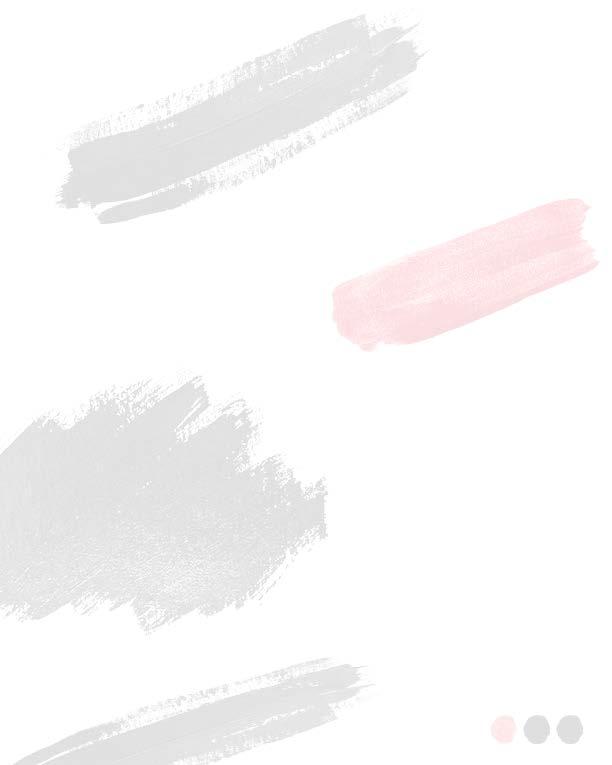
Growing Market:
According to a report by ArtNet, the market for work by Black American artists witnessed a remarkable surge of nearly 400% between 2008 and 2021. This growth is a testament to the increasing recognition and appreciation of the artistic talent within this community. However, it is worth noting that this expansion has not been consistent, with acquisitions peaking in 2015, two years after the emergence of the Black Lives Matter movement.
Limited Market Share:
Despite the growth, investment in Black American artists still represents a small fraction of the global art market. Sotheby’s reported that approximately $2.2 billion was spent on artwork by African American artists at auction over the past ten years. While this figure may appear substantial, it represents a mere 1.2% of the global auction market, which amounted to $180 billion during the same period (according to the artnet Price Database, 2019).
This History of Black Artists in America:
Understanding the historical context of Black artists in America provides valuable insights into the significance of investing in their artwork. Charles Moore’s “The Black Market: A Guide to Art Collecting” offers a brief history that contributes to our interest and insight into art collecting in this space.

Moore highlights the long-standing challenges faced by Black artists in gaining recognition and opportunities within the art world. Discrimination, systemic biases, and limited access to influential institutions have historically hindered the success and visibility of Black American artists.
However, Moore’s book also showcases the resilience and creativity of Black artists, who have persistently found ways to create and share their work despite these barriers. It sheds light on the rich cultural heritage and unique artistic expressions that have emerged from the Black American community.
Investing in the Future:
Investing in black artists not only provides financial opportunities but also contributes to creating a more equitable art industry.
Supporting the growth of Black American artists can lead to a more diverse and inclusive representation within galleries, museums, and auction houses. By investing in these artists, investors can play a crucial role in promoting their work and ensuring that their contributions are recognized and valued.
Black Artists are Substantial and so is their work.
If you’re interested in starting an art collection we encourage you to check out our article with Marjorie Hodges.
Jean Michel-Basquiat, Untitled (1982).
Konish, L. (2023, February 25). How Representation of Black Artists in Galleries, Museums Is Changing. CNBC. Carrigan, M. (2022, December 13). Black American Women Artists Represent Just 0.1% of Auction Sales, Report Shows. The Art Newspaper Burns, C. and Halperin, J. (2019, February 13). For African American Artists, the Market Remains Woefully Unbalanced. Sotheby’s
Richard
WILSON, JR.
CAPTURING MEMORIES AND CONNECTING THROUGH ART
Richard Wilson, is a fine artist hailing from eastern North Carolina. Inspired by his father’s skillful drawings of him and his siblings, Richard has been painting since the age of eight and has become one of North Carolina’s celebrated artists. With his unique approach and unwavering dedication to his craft, Wilson is inspiring others with his talent and determination to be one of the greatest.
Wilson’s journey as an artist is a testament to the power of following one’s dreams and being intentional with your gifts and talents. His award winning work has been exhibited in numerous galleries around the world, receiving critical acclaim and attracting a substantial list of art enthusiasts like Hank Aaron, Gladys Knight and Tina Knowles. From becoming the first Black artist to have a painting displayed inside a North Carolina Courthouse to having his art featured on the label of Blue Moon Beer and on the big screen, Wilson is capturing memories and connecting through art.

10
Tell us about Richard Wilson growing up in rural eastern NC?
I had a great childhood. I grew up with two brothers and I’m the oldest of three. My mom and dad taught us how to work hard. I remember working on the farm early in the morning and going from the tobacco field to the football field. I also remember summers at my grandmother’s house, she taught us how to be resourceful and self-sufficient and those lessons stick with you.
I also remember sitting around the table and watching my father draw me and my brothers—it was amazing what he was able to do with a pencil and a piece of paper.
Did you always know you were going to be an artist?
As I mentioned my dad was an artist, and in the small town we use to live in called Conetoe he painted all the signs in the town. I remember I used to help him paint those things and in a way painting those signs helped me with my graphic design abilities. I actually went to school for graphic design and was, still am a graphic designer. I honestly caught the bug and fell in love with painting from watching my dad make his work look as though it was going to jump right off the paper. I also had a really great support system and people around me that encouraged me along the way. I remember when I was in the seventh grade my English teacher would always ask me to sign all the certificates because I had nice penmanship and I really enjoyed during it because it was related to my art. One of the proudest moments during that time was when the teachers came to me and ask me to draw Black leaders like Martin Luther King, Harriet Tubman, and other civil rights and community leaders for them and I was so excited to do it. After I had drawn all those great Black leaders and came back to school that next week I was so honored to have my drawings up on the bulletin board in front of the principal’s office. What really did it for me was to see at the very top of the board it read “Featured artist, Richard Wilson,” that blew me away, because they believed in me and they supported me. It was moments
like that one that boosted my confidence and really made me feel like I can really do this.
Another moment along the way was when my dad enrolled me in art school. I was 11 years old taking correspondence courses at the Art Institute. It was those courses where back then you did the lessons and sent it back to them to grade, and then they’ll send it back to you. That was another one of those times when my dad and my mom, they supported me and invested in me. They really helped shape my art career early in life. They not only supported me but my brothers as well, we all were so talented.
Tell us about a defining moment in your art career. I would say I’ve had a few moments but when I won my first major show in New York that was a great feeling. I won top prize in the Pastel Society of American International Art Competition and as a small town artist at the time I was blown away. I was living in Tarboro, NC at the time and there weren’t many outlets for my art. It was a small rural town and community—while everyone in the area supported my work it wasn’t much more than local exposure so winning this international competition was an honor. I’ll be honest I just remember how determined I was to get my work in the competition, I even took vacation from my job to just coordinate shipping my work for the exhibition. When I got that phone call that I had won, I just had so many emotions I couldn’t even tell my wife the news, I was just crying, smiling, it was just so much because it was like a weight had been lifted off me. With all the stress of getting it shipped in time, having to pay additional fees because it was a large piece, just all the wondering, it was such a relief.
I remember going up to New York and receiving my award and prize money. I also remember getting to meet with the founder of the Pastel Society and the President of the National Arts Club taking me and my wife out to breakfast. He was a huge supporter and really helped me in
11
so many ways. He took me and my wife to breakfast and gave me another $500 check on top of the $1,000 in prize money that I received for winning the competition. He also took us to an art supply store and told me to get whatever art supplies I needed. I remember him telling me he saw something special in my work and he told me to use this as a stepping stone. One more thing he did for me was he wrote a press release and sent it around to all the local newspapers in North Carolina, and a number of papers ran that release. That was one of my defining moments for sure because there were over 2000 artist in that international competition—I was competing with artist from all across the global and I won top prize. I knew then I was really on to something.
Speaking of of top prizes and awards, tell us about some of your many accolades and recognitions in the art world. Wow, I’ve been so blessed and I believe it’s because I basically stepped out on faith. I have a painting called “Faith Journey,” which is based off me when I stepped out on faith. I used to teach art in college and I remember I was just doing my shows on the side and scheduling around my full-time work, I told my wife I have to do this, I have to try and do my art full-time and she was so supportive. I won’t lie in my mind I was like “you have three daughters, what are you doing,” but I also remember telling myself “you only live once, follow your heart.” I went to an art show that weekend after I made the decision to transition to full-time artist and I made more money from that one show than a full years teaching salary. So when you look at my “Faith Journey” piece and you see the little boy looking back and the little girl looking forward and seemingly pull him along, that’s me. Once I realized fear was what was holding me back from my full potential and I started to face that fear it was like the world had opened up to me.
Again it’s been a blessing and an incredible journey thus far. I was featured in The Wall Street Journal and recognized by writer Daniel Grant as “one of the most successful artist that you’re likely to meet,” my work has been featured in five movies
and a number of TV shows—from Netflix movies and series to one show on NBC, This Is Us. I’ve been commissioned by the University of Georgia, famous art enthusiast like Hank Aaron and was the first Black artist to have a painting displayed inside a North Carolina Courthouse. There have just been so many blessings. Going back to the Pastel Society of American International Art Competition, I’ve won top prize twice now and I’m one win away from being named a Master Pastelist and being inducted into the Pastel Society of America Hall of Fame. My very first time entering I won top prize with my piece “Between Us” that was a painting that feature my oldest daughter and the second time was a piece featuring my youngest daughter—that piece is called “Push Daddy, Push” which also is the cover of a children’s book written by Nacole Powers. So I said I wasn’t going to enter again until I had a piece that I could submit of my middle |daughter and it doesn’t matter if I submit and don’t win, I plan to submit again until I’m able to win with a piece with her featured. Then I want to pass down the originals to each of them.
What do you want people to take from your work?
I want people to know that there is greatness inside all of us, you just have to tap into what’s already there. You have to walk toward it and push and never give up. There have been times that I could have given up but I just won’t let anything stop me. It’s really why I like to tell these amazing stories in my work. Stories like Bessie Coleman who was an early American civil aviator. She was the first African-American woman and first Native American to hold a pilot license after being denied flight training in the U.S. so she went to France, came back and was an amazing pilot and taught others. She never gave up. Folks like Jim Brown, Muhammad Ali, Joe Louis, Charlie Sifford and so many others—just never gave up on their dreams. Their stories are my story and I want to play a part in telling those stories.
12
What’s some advice you would give to other artists?
Just manage your time, and don’t let anything stop you. Sometimes I overload myself and I thank God I have my family. My wife tells me you need to cut back, you need to take a pause. So managing your time and making sure there’s some sort of balance.
What’s on the horizon for Richard Wilson, Jr.?

Well you can look forward to more work, but my ultimate goal is to open up a gallery some day. I want to continue to share my work with the world and have a place where folks that can’t travel to shows can come and see my work and the work of others. I want a homebase that I can share with other artists and create a supportive, encouraging community like I had.
What makes Richard Wilson substantial?
I’m substantial because I listen to the voice inside of me that that says “I’m great, that I am excellent.” I’m substantial because I strive to make my ancestors proud of who I am and what I’ve done. There are so many people that have made major contributions to this world and we don’t hear their stories and I want to help share them and carry on their legacy. They were here, I am here, and there are more to come.
13
Visit: richardwilsonart.com | IG: @richardwilsonart VISIT WEARESUBSTANTIAL.COM FOR EXCLUSIVE VIDEO CONTENT.
Aliyah BONNETTE
WEAVING AND PAINTING THE STORIES OF OUR COMMUNITY
Aliyah Bonnette is a 24-year-old mixed media quilter who grew up in Silver Spring, Maryland. She uses quilting to connect with her grandmother and her previous ancestors. In her work, she explores being a Black woman in America, sexuality, and connecting with one’s ancestors as a “displaced diaspora.” She has received multiple awards, including the Black Girl Who Paints Award and the Caroline Allen Memorial Scholarship. She’s leading a stitching and embroidery workshop at NC Museum of Art in July.
 Written by Joelle Adeleke Photography By Jonathon Leach
Written by Joelle Adeleke Photography By Jonathon Leach
14
Growing up in a household centered around Blackness, Aliyah’s mother instilled in her a strong sense of Black pride and representation. It was in this environment, coupled with her move to North Carolina at the age of 16, that Aliyah’s creativity flourished.
While studying art in college, Aliyah became fascinated with fabric and dye classes, which led her to discover the historical significance of quilts in the Underground Railroad. This revelation sparked her interest in quilting as a means of processing her experiences as one of the few Black individuals in predominantly white spaces. When Aliyah decided to make a quilt, she learned that her grandmother had been a quilter, and her grandfather had preserved all her unfinished work and materials. This connection to her grandmother and the family tradition motivated Aliyah to teach herself how to quilt.
As a Black female artist, Aliyah faces unique challenges in the art world. She discusses the difficulties of entering white-dominated spaces, such as galleries and museums, where the representation of Black artists is statistically low. Networking is another hurdle, as a Black woman in the industry, but Aliyah remains resilient and determined to fight for her work and beliefs.
Aliyah’s creative process involves writing as a form of self-expression and exploration. Often, she writes before visualizing her artwork, using her words to gain insight and clarify her ideas. This practice allows her to address the emotions and thoughts that she may struggle to convey verbally.
In Aliyah’s view, she is substantial because her quilts embody her entire being. She meticulously selects fabrics, sews them together, adds details, paints, beats, and embroiders, giving her complete control over every aspect of her work. Through her art, Aliyah expresses her identity, connects with her ancestors, and challenges the limited representation of Black artists in the art world.
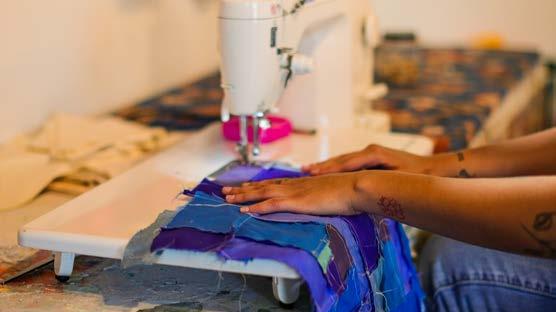
15
SM: What would you say to your younger self?
AB: Oh, gosh, keep going. Do not stop. I think that I was, scared in the beginning, but I was also working when I was in school to make sure that I’m in the spots that I am in now. So I would say you just have to work hard, that it has to be your priority.
SM: What makes Aliyah substantial?
AB: WOW! I’m substantial because I’m substantial. Because every piece of my being is in my work. From the fabric I pick out and I sew together, to the details I paint on it or embroider, I’m in control over every aspect of what I’m doing and the story that I tell.

16
Jalen JACKSON
THE POWER OF NOSTALGIA
Jalen Jackson, an oil painter hailing from Durham, North Carolina, is making waves in the art world with his captivating and thought-provoking work. As the first HBCU (Historically Black Colleges and Universities) student in residence at the Artspace in downtown Raleigh, Jalen is breaking barriers and using his art to challenge stereotypes and uplift his community.
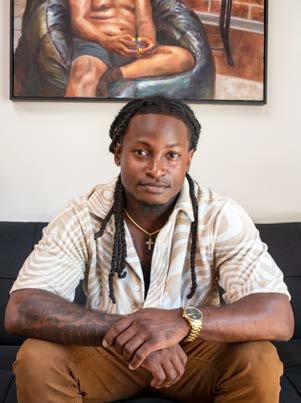 Written by Greg H.
Written by Greg H.
17
Photography By Sanjé James
For Jalen, the opportunity to be in residency holds great significance. It provides him with a dedicated space to explore new ideas and be part of a vibrant artistic community. Being chosen for this residency based on his graduation from an HBCU, North Carolina A&T, adds an extra layer of pride for Jalen. He sees it as a chance to represent his college in a positive light and defy any negative stigmas associated with HBCUs.
Born and raised in Durham, Jalen draws inspiration from his memories and experiences growing up, particularly his strong and resilient mother. She serves as his greatest muse and motivator, instilling in him a sense of gratitude and a desire to create artwork that tells relatable stories. Jalen’s paintings aim to evoke a sense of peace and nostalgia, allowing viewers to reflect on simpler times and appreciate the journey they have taken.
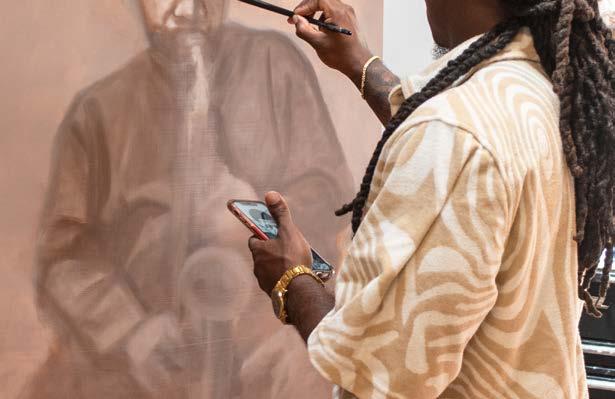
One of Jalen’s notable series centers around single mothers, aiming to challenge the negative narrative surrounding their ability to raise successful men. His artwork shines a positive light on mothers who have dedicated themselves to raising their children, defying societal expectations and stereotypes. Jalen’s piece titled “Reasons He Never Went to Sleep Hungry” tells the story of how his mother ensured he had food, clothing, and a secure environment, despite their challenging circumstances.
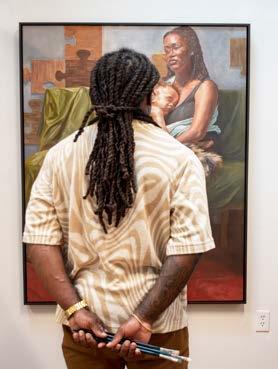
18
When asked about what he wants viewers to take away from his work, Jalen emphasizes the importance of appreciation and connection. He hopes his paintings serve as a catalyst for people to reach out to their loved ones and express gratitude for the role they played in their lives. By inspiring others to reflect on their personal stories and find solace in his art, Jalen aims to create a positive impact.
Jalen Jackson’s art is substantial because it carries the power to inspire and uplift. By telling stories that resonate with others, he fosters a sense of connection and reminds viewers of their own strength and resilience. Jalen’s work serves as a testament to the profound impact that art can have in transforming lives and shaping communities.
As Jalen Jackson continues to grow as an artist, his dedication to telling stories and creating positive change shines through his artwork. Through his resilience and determination, he proves that art has the power to inspire, heal, and empower, making him a true force to be reckoned with in the art world.
SM: What do you want people to take from your work?
JJ: I try to go for nostalgia with my work, I want people to look back and reflect on a good time or a time where things were simple. A time when things weren’t so complicated. I know that may not be the same for everybody, but maybe at least one piece that I create, someone can relate to it and say “oh, wow, I remember that time.” I want people to see a piece of my work and call their parent or guardian and tell them they appreciate them.
SM: What’s a piece of advice you’d give to other young or up and coming artists?
JJ: Almost every artist I know, has been through a time where they struggle with believing in themselves and they struggle with confidence. They may have heard someone say something about their work or to them about their work. I say use it as motivation. Especially the negative. Find a way to make it positive, find a way to channel it and use it. Don’t give up, know your purpose, know what you want to do and what you want to create.
19
Randy ROGERS
5 QUESTIONS WITH ARTIST freedom clay
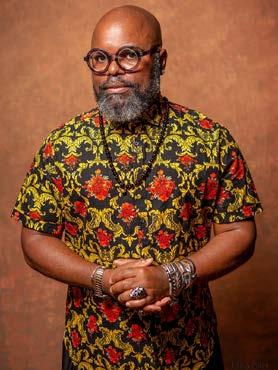
North Carolina is home to many artists that embody diversity, culture, and creativity. One of those dynamic artists is Randy Rogers who is artistically known as freedom clay. When I first saw his artwork, I immediately noticed his art tells a story. It reminds the viewer of moments in time such as his piece entitled “4 Little Legacy Girls” or “Clay Man the Bull” which are engaging examples of artistic expression. I had the opportunity to ask freedom clay five questions about art, where he draws his inspiration, and what North Carolina artists he likes.
Written by Kimberly Knight
20
Photography provided by freedom clay
1. AS AN ARTIST, WHEN YOU VISIT ART MUSEUMS OR EXHIBITIONS, WHAT IS THAT EXPERIENCE LIKE FOR YOU?
As an artist/creator, when I visit art museums/exhibitions, it’s nourishing to my being. The experience provokes so many vast feelings and emotions from euphoria, nostalgia, pride, elation, anger and sadness. The experience also inspires moments of stillness, reflection, meaning making and inspiration. It’s like having a favorite meal and I’m intentional about taking my time to savor every delectable bite. Moreover, these special moments are centered in gratitude because I’m able to bring ALL my senses to the experience: creating a well-rounded and multi-faceted moment in time.
2. WHERE DO YOU FIND INSPIRATION TO CREATE YOUR OWN ARTWORK?
I find my inspiration to create my own artwork from lived experiences, observing the lived/living experiences of others, nature, other expressions of art, music and responding to our current and past socio-political conditions. My artistic inspiration is mostly inspired by life and life events.
3. IN NORTH CAROLINA, WHAT ART SPACES DO YOU LIKE TO VISIT?
I enjoy the NC Museum of Art in Raleigh, Hayti Heritage Center, Sabrina’s Gallery in High Point, Nasher Museum of Art in Durham and the 21c Museum Hotel Durham. I also really enjoy visiting art spaces in Asheville and other quaint towns in NC.
4. WHAT IS ONE OF YOUR FAVORITE ART EXHIBITS YOU HAVE SEEN AT THE NORTH CAROLINA MUSEUM OF ART? (IF ANY)
Wowzerz, I’ve seen so many incredible exhibits at the NC Museum of Art; however, I would have to say one of my favorites to date is the “50 Years of Ebony Fashion Fair” because it reminded me of my childhood/adolescent experiences going to see the Ebony Fashion Fair Show annually at the High Point Theatre. It was always a memorable night of Black elegance and excellence. I also loved getting “dressed up” for the occasion.
5. WHO ARE SOME OF YOUR FAVORITE ARTISTS IN NORTH CAROLINA?
This is another challenging question because there are so many talented creatives in NC. Some of my favorite artists are Beverly McIver, Clarence Heyward, Shambomedina, Lennie Vernet and Sabrina Tillman. This is just a handful.
Social Media facebook.com/afrofolkartbyfreedomclay/ instagram.com/freedomclay/
21
Clarence HEYWARD
15 MINUTES WITH AN ARTIST

Clarence Heyward, a renowned artist whose captivating portraits capture the essence of black experiences, has emerged as a prominent figure in the art world. With his distinct style and dedication to his craft, Heyward has been making waves in the art community, using his talent to document history and challenge societal norms. Born and raised in the vibrant city of Brooklyn, New York, Heyward grew up with a deep appreciation for art. As a city kid, he witnessed the struggles of everyday life and found solace in the power of artistic expression. Summers spent in the South and his family’s roots in South Carolina provided a unique perspective, shaping his understanding of culture and identity.
Substantial got the opporunity to catch up with Clarence in his studio to talk about his life, his work and what it means to be an artist.
 PHOTOGRAPHY BY TREY JOYNER
PHOTOGRAPHY BY TREY JOYNER
SM: What has been the inspiration for your work?
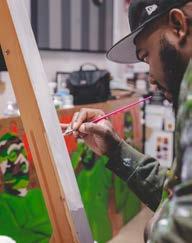

CH: One of the biggest inspirations for me came back in 2008. Me and my wife went to an exhibition by Barkley Hendricks called “Birth of the Cool.” It was the first time I walked into a museum space and it was filled with portraits of black people. There were these massive life size portraits, everywhere. It’s like black people, black people. I’ll never forget, there was this one portrait that he did and it looked just like this picture I have of my pops. I never really knew my pops but I always had this picture. So when I walked in this space I saw myself. You know people say you can often see yourself in the art. I not only saw myself, I saw my family. From there I wanted to give people that feeling. I wanted the art to be super relatable and something they can connect with. So ever since then I just wanted to follow his work and studying him. So that’s probably my biggest inspiration for why I paint portraits and why I use portraits to tell my stories.

23
Art Is ...


SM: So what do you want people to take from you?
CH: That’s a trick question. So I don’t necessarily want them to take anything. I want them to see it and decide for themselves what they see and what they take from my work. I want them to see me. I guess I want them to be able to connect to my work, even if they don’t share the same experience but to be able to at least understand what I’m saying or understand what the people in my portraits primarily my family are experiencing at the time. I want my work to serve as documentation. I’m not really making the work for people who will view it right now. I’m making it for people a 100 years from now can reflect on it. They can see what was going on during my period. So, in essence, right, this is just history, we just haven’t gotten to the point where it’s really history yet.
SM: What was that moment when you said “yeah I’ve made it.”
CH: Yeah, I still don’t feel like that. Because every level you reach, I assure you there’s another level you can get to. That’s kind of what keeps you going. I haven’t wake up and said, “I made it,” and if I ever do then something went wrong, because I should always keep striving to be better. I’m never going to feel like I made it. For one, there’s always people ahead of you and there’s always people behind you. There are a lot of young artists that motivate me and a lot of artists that I aspire to reach the level of. I’m looking at people who’ve been doing it longer than me and I’m saying that’s what I want. When you see you’re work in spaces and people relate to it or they talk to you about it, and they tell you how it affects them those are some defining moment don’t get me wrong. I can say I made it, I can say I’m able to live off my work don’t get me wrong, but there are still new levels I strive for.
SM: Have you experienced challenges as a Black artist?
CH: I mean, since I don’t really separate being a Black man from being a Black artists, yeah there are challenges. The world is filled with its share of challenges, but I mean, I don’t hold it against people. I hope people will look at my art not just because of who created it but look at it through their eyes and experiences and understand the story its trying to tell. Part of the reason I’m doing this is to expose people to the culture and let them understand what we deal with and what we go through and how it makes us feel. When you look at some of my work with the masks, the mask is almost how you make us feel that it’s not necessarily like because the people are in masks that they’re preparing to rob a bank. However some one may see it and immediately think that but is that because that’s what they’ve been exposed to. So all I can do is expose them to something else and hope the story that I’m telling helps them see things differently.
SM: Do you have a favorite piece?
CH: I tell people whatever I’m working on is my favorite piece. I say that because I get better with every piece. I learn things from each painting. There are somethings that I do now that I couldn’t have dreamed of doing when I first started. There are also somethings that I see other people do and I’m like, I’m dreaming of doing that. Of course, I have pieces that I’ll never sell or that are in my private collection but even still they’re not my favorite or anything like that. Some of those pieces are just firsts for me, like the first time I painted with gold or painted my wife and kids.
SM: What’s some advice you have for other artists?
CH: I’d say work every day, as much as possible. A lot of people think they can make one painting and that’s gonna be it. You’re just problem solving and just figuring things out. First time I painted a sneaker, it didn’t look like a sneaker I’d paint today, and I’ll learn something from it each time and build on it. You have to just keep going. Nothing’s too precious. I used to be like “oh man, this has to be perfect, I’m gonna live with this forever.” But now it’s just like, efficiency. Whatever I do it’s okay. This is where I am today. This is the best thing I can make today. I’ve given myself to this painting and put my talents into this painting. Tomorrow, I’ll strive to be better because I can build on what I learned. And I just keep going.


Visit: clarenceheyward.com
IG: @clarenceheywardart
VISIT WEARESUBSTANTIAL.COM FOR EXCLUSIVE VIDEO CONTENT.
Christopher EVANS
PAINTER, TATTOO ARTIST, ENTREPRENEUR
Christopher Evans, the owner of Good Trip Gallery in downtown Raleigh, is not your average artist. As a full-time artist, entrepreneur, and creative, Evans has made his mark in the art world with his unique style and diverse range of talents. In this behind-the-scenes conversation, Evans shares insights into his creative journey and how he navigates the art scene.

Evans, a native of Wake County, North Carolina, has been an artist for as long as he can remember. From his early days with drawing books and doodling on anything he could find, he knew he had a passion for creating. As he grew older, his talent and passion for art became more apparent, and he started selling his work in middle school. It was during this time that he realized he could turn his love for art into a career.
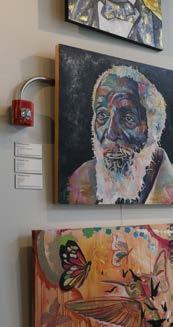
One aspect of Evans’ artistic journey that sets him apart is his foray into the world of tattooing. Taking his skills from canvas to skin, Evans seamlessly translates his artistic vision onto a different medium. Although the process may differ, the
There
Visit: goodtripgallery.com
IG: @goodtripinc
26
in yourself,
is only you and
for what
“
core elements of creativity and idea generation remain the same for Evans, whether he’s painting or tattooing. When asked about how he wants people to view his work, Evans emphasizes the importance of evoking emotions. Each piece he creates is unique, but his ultimate goal is for viewers to feel something, whether it’s a connection, inspiration, or even a sense of discomfort. Success, for Evans, lies in the ability to elicit a response from the audience. One notable aspect of Evans’ artwork is his portrayal of black figures. He believes in celebrating and recognizing the achievements of black individuals who have

made a significant impact in their respective fields. From iconic figures like Muhammad Ali to lesser-known inspirations, Evans uses his art to shine a light on those he admires and respects. Reflecting on his journey, Evans acknowledges that his biggest challenges have often been self-imposed. Overcoming self-doubt, procrastination, and not reaching his full potential were the obstacles he had to face. However, he believes in constantly improving his skills and pushing himself to achieve greater heights. With numerous exhibitions and shows lined up throughout the summer and fall, Christopher Evans continues to make his mark in the art world. His journey serves as an inspiration to aspiring artists, entrepreneurs, and creatives, reminding them that success is built on passion, perseverance, and the willingness to embrace new opportunities.
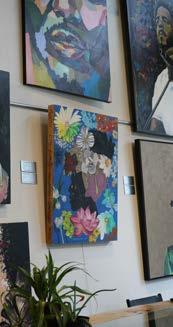
27
PHOTOGRAPHY BY GREG H.
and your many canvases. The limitations in your work are what we see is what we are.”
~ Chris Evans
Jaki
SHELTON GREEN
Words from the Poet Laureate
Jaki Shelton Green is the first African American and third woman to be appointed as the North Carolina Poet Laureate. Green is a highly esteemed figure in the world of poetry. Born and raised in North Carolina, Green has dedicated her life to the art of writing and spoken word. Her work explores themes of identity, history, and the experiences of African Americans. Green brings a deep appreciation of our state’s diverse communities to her role as an ambassador of North Carolina literature.
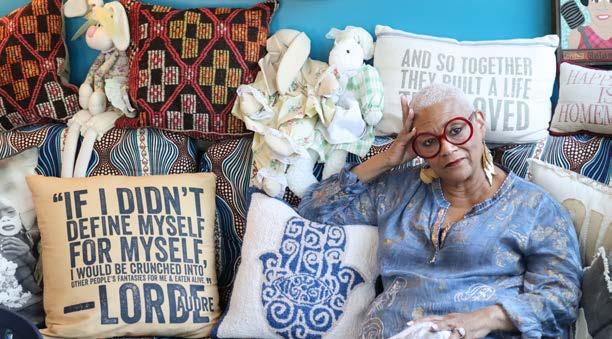
28
PHOTOGRAPHY BY TREY JOYNER
Green has published numerous collections of poetry, which have garnered critical acclaim and accolades. She is known for her powerful performances that blend poetry, storytelling, and music, captivating audiences with her compelling presence.
In addition to her literary achievements, Green is a passionate advocate for social justice and community engagement. She has used her role as Poet Laureate to promote poetry as a means of healing and empowerment, leading workshops and mentoring aspiring writers across the state.
When did you know you wanted to be an artist?
Well, I really didn't know I wanted to be a poet. I wanted to be a scientist growing up. Growing up, I wanted to be an oceanographer. I was obsessed with the ocean, even though I had never been to the ocean. I'd never seen the ocean, but I had watched enough Jacque Cousteau on Saturday afternoons, and I knew that I wanted to be a marine biologist or an oceanographer. I wanted to get to the bottom of the ocean. And it was really my grandmother who sort of nudged me into writing. I was a very nosy child and I've come to learn that being inquisitive is necessary. As a creative maker. We really need to be nosy. All of us, musicians, poets, dancers, filmmakers, sculptors, we need to be nosy.
We need to be, we need to want to know what makes that tick. What makes that move, what makes yellow, yellow, and I was that child. In church, I loved going to church, but it was too long as a child. So you know, 15 minutes probably felt like three hours to me. But my grandmother would give me little notebooks to write in. And I would sit there and you know, in my little pea brain mind, I was making little stories about what was going on around me. All of the nuance of growing up in the South, growing up in a rural community in the South has informed my writing.
What does it mean to be a Poet Laureate?
Well, I serve as the ninth Poet Laureate of the state. I'm only the third woman and I'm the first African American. When I was appointed as the North Carolina Poet Laureate in 2018, by Governor Cooper I'll never forget it. Governor Cooper called me on my birthday—my cell phone rings, and it was a Raleigh number, so I answer it. And he said, "this is Roy Cooper calling for Jackie Shelton Green," and I said in a very snippy voice, "Yeah, right. Like my Governor Roy Cooper." And he said "Yeah, that's right, like our Governor Roy Cooper." I went, oh how can I help you? And he said, "Well, I'm calling to inform you that I just appointed you as the ninth Poet Laureate for North Carolina. And I screamed in his ear. Embarrassingly, I was screaming, laughing and crying all at the same time. When I am anywhere standing at a podium or speaking, in that role as
become shroud dirty rags of a holy book that supposedly forgot to stand vigil over our children ransomed to sun beneath each month’s moon hidden or full the daughters of other mothers themselves likely near death send us prayer shawls send us poems send us slabs of crystals a mother opens her mouth it is always wailing blood metallic bullets ride the mucous in her throat tease the pregnant ball of fire brewing inside her head we open our mouths to allow the blood to speak through light that does not choke the blood speaks through light that out races breath mothers swallow all the blood their stomachs can hold licking sidewalks playground swings back seats of dirty cop cars we become vampires who have no fear of light who have no fear of sexy silver bullets trying to crawl up our thighs we no longer fear the photographs of our children dying with mouths wide open their last sentences holographic prayers caught in between flash and light we sprout swords smiles that curse the memory that your first word was light is the balm traveling quieting a hysterical womb your first word was light now you swim with dolphins feeding them tiny particles of light filament your small teeth would chew and chew all the light your mouth could hold you later fed the ice to your baby brother calling crushed ice stars for a baby brother it has been a year full of a thousand years each month each day chasing the other inside my womb pulling grasping cramping for a blood birth of history herstory already told already buried already rotten a year full of limp apology dead proclamation faceless monsters breaking the shadow dance of other children more mothers drink the blood appear in daylight wild eyes speaking searing truths our daughters hold so much of the mothers grief inside their own wombs that become tombs for babies that scream no i’m not coming to this world this plight this revolution that is brewing inside a vampire’s apron pockets inside grandmother’s kitchens where they are stitching witching weaving brewing ancient fodder to feed another storm of harnessed lynched shackled light mothers become a season unto themselves storing winter blood mothers have become too familiar with death as personal as the found wisps of a son’s single strand of hair or the stale perfume stained handkerchief folded hidden inside your child’s pocket we are reminded in between each touch of warm lavender jasmine lemon cypress water cleaning stroking kissing soothing the cavity created by nine sexy silver bullets that we are mothers swimming strong in rivers so ancient they need no names in between the honey and rosemary balm massage in between each finger each toe we are reminded that we have always buried our dead and we have always raised our dead we are ancient vampires reckless eating stars lights full moons sexy silver bullets blue monsters we are strange language strange face strange dance we are the ghosts of all the children speaking through the smoke.
29
Poet Laureate, I know I'm not standing there alone, I know that standing around me are generations of ancestors who have been nudging me for all my life, encouraging me to go into these spaces where we have not been invited, where we have been disallowed to be in. I also know that I stand there with unborn generations, as the model of we can do anything we want to do. So it's very meaningful to me, I take it very seriously. I'm the ambassador of literary arts for the state of North Carolina. My mission is to advance, enhance and expand appreciation of literature across the state. I do that by traveling across the state, inviting people to write, to tell their stories, and I help them understand the value of their stories. It's not just about my stories, but their stories are what help fuel the arts.
How does one use the arts for the purpose of healing, to create movements and inspire others to change? Well for 40 plus years I have been using writing as therapy and as a form of healing. I've had residencies in prisons were I worked with incarcerated writers and writers on death row. I've worked with young people who are in detention centers. I've worked with people who are survivors of domestic violence, who are survivors of incest and other traumas. I've worked with writers living in homeless shelters and people living on the street. In all of these spaces I have witnessed over and over again the power of how the arts have and can save lives. I've learned more from those audiences, perhaps, than they've learned from me, because as I said it's not just about my stories, it's about their stories and their experiences.
What advice would you give an aspiring writer?
As I said earlier in our conversation creatives most be inquisitive. I would tell them to take classes and learn their craft. I would tell them to expose themselves to other writers, there are some brillant minds right here in our state. North Carolina is full of very gracious, generous writers. We've got poet laureates in cities and counties. We're here, reach out to us, get involved. As a young writer you should go to readings. I'm always fascinated when someone tells me this is their first poetry reading or this is the first time I've ever written and read my work out loud. As a creative you have to take those chances. The best way to sum it up is to say don't be afraid. Don't be afraid to be yourself. Be yourself. Don't try and be the next Maya Angelou or Nikki Giovanni. Be the first and only you. You have to have a relationship to your work, to your art. What is your relationship to your poetry, short stories, whatever you're writing? It may sound strange when I say this but how are you treating your work? Are you spending time with it, do you love it? As writers and creatives we have to pay attention to the things that pop up around us and write them down.

30
PHOTOGRAPHY BY TREY JOYNER
Of all your amazing work, do you have a favorite?
Well, out of my nine collections of work, there's a piece that I wrote about my daughter. My oldest daughter died in 2009, at the age of 38. I really wanted to write about her. It was not until 2017 that I was actually able to write about her and I have a publication that's entitled, "I Want to Undie You." It's one long poem. It's not a collection of poetry. I hate to use the word favorite, but it's perhaps the most significant body of work for me. It was important for me to be able to honor her life, her legacy, her legacy of humanity, her legacy of service. It was also significant for me because it modeled how we use creativity as medicine, and it was the medicine that I needed at that time. Creativity and the arts, I do believe that creativity is medicine, writing dancing, painting, photography, sculpting, singing as we said earlier it heals.
What's on the horizon for Jaki Shelton Green?

Oh, my I have so many things going on. A lot of artistic collaborations in the works. I met the other day with somebody who wants to make another dance film video with me. Since with the first one we did was so successful. I have a lot of work and projects in Morocco that is lining up, so I'm just staying busy. I have not published anything in a while, so I'm definitely dedicated and committed to bringing out a book or two by the end of the year. So stay tuned because a lot is happening.
Visit: jakisheltongreen.com | IG: @greenjaki
31
VISIT WEARESUBSTANTIAL.COM FOR EXCLUSIVE VIDEO CONTENT.
NC Poet Laureate, Jaki Shelton Green reflects on her work during an interview with Substantial.
Maya BROOKS
A CONVERSATION WITH A CURATOR OF CONTEMPORARY ART
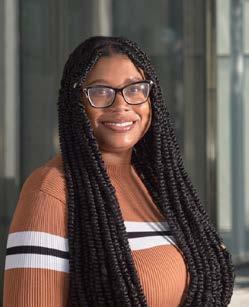
How and why did you become a curator?
As a teenager, I decided on a museum career after reading about Anthropology in a class textbook. I searched the types of positions I could seek with at least a Bachelor’s degree in the subject. Museum Curator was the first result. I decided that made the most sense for my interests and personality.
Before then, I was obsessed with Barbie houses, but not the dolls per se. I would glue all these plastic pieces together to make makeshift “house museums.” So, museums and interpretation were always there for me. I just didn’t recognize them as such until much later. Pair that with my being extroverted and fascinated by history; it all aligned.
I didn’t have many examples of what this work could look like, especially for someone with my background. My closest inspiration growing up was Johnnetta Cole. She is also an Anthropologist and former museum professional. I would sit and watch videos of her speaking while she was the Director of the National Museum of African Art. Other than her, I didn’t have much guidance about how to enter the field, let alone exist in it, so I had to piece this life together over the past nine years pretty independently.
32
What does your role as a curator at the NCMA look like day-to-day?
I get asked what my day-to-day consists of pretty often –it is mostly feeling stressed about the small details of all these moving parts and questioning myself for choosing this path. I got asked by a photographer friend if he could shoot me for a project exploring my time at the museum. I told him it wouldn’t be any good because it would be photo after photo of me with my head on my computer.
I’m joking, of course. I love that my days rarely look the same throughout the week. I have meetings here and there – most are with internal teams, but I also often speak with artists and community partners. I travel to their studios or homes, gathering information about future projects or ways we may collaborate. I work closely with local universities and colleges, too.
I tend to prioritize my day with the projects I’m working on. I start with exhibition work, from drafting checklists to writing labels. I also spend time researching subjects and artists throughout the day. Working in contemporary art means I usually use digital resources, but I still love browsing through physical catalogs and collection texts. I have a running list of exhibition ideas and artists I’m interested in on my computer. When I need to find an idea, I pull it from there.
What projects are you most proud of?
My most significant project to date has been the NCMA’s collection reinstallation, which I was hired to assist with three years ago. This project included restructuring all the galleries to provide an equitable representation of our collection. We strived for “equity” instead of “equality” because the collections are diverse in size and media. It was like putting a puzzle together. Since I work in contemporary art, I was responsible for reintroducing our “Global
Contemporary” collection. This also included acquiring new work and supporting loans outside the museum to bolster the collection’s inclusivity.
It’s funny; I had a real full circle moment during our planning stages because the curators used a model of the museum that we called the “doll house” to figure out where we would place all the artwork. It really brought something out of me.
What was your experience bringing the Ruth E. Carter exhibition to the Museum?
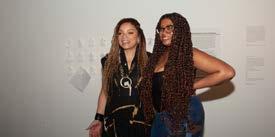
The exhibition provides a great opportunity to recognize Ruth’s life and career. I’ve been a fan of hers since I was about eight years old when I watched Do the Right Thing for the first time with my father.
My Chief Curator, Linda Dougherty, told me we were bringing the traveling exhibition to the NCMA. I remember going, “What? No way!” She asked if I would like to serve as the coordinating curator, a role institutional curators take on when the show is curated externally, and I jumped at it since I was familiar with Ruth’s work.
I worked with the show’s originating curator, Julia Long, to coordinate our version since the exhibition looks different at each location. We worked with a team of designers, contractors, art handlers, and other development directors to bring everything to fruition. It is a months-long process of
33
Academy Award winner Ruth E. Carter and Maya Brooks pose for a photo during Carter’s exhibition opening at the NCMA.
conversations and file-sharing between departments and external organizations that can feel daunting but is worthwhile once it’s all put together.
How have exhibitions expanded under your leadership?
My practice reflects a quote by scholar and civil rights advocate Kimberlé Crenshaw:
This quote refers to how we can subvert oppressive systems throughout our culture. This relates to my work as a curator by challenging how we (the museum, curators, people, etc.) relate to and disseminate global experiences. I aspire for my work to challenge the limits enforced upon historically marginalized people and how we express our abilities, our strengths, and our potential as we navigate injustices. My exhibitions evoke another concept articulated by Crenshaw, intersectionality. This analytical framework describes the social phenomenon where we cannot separate our experiences based on our disparate identities. They act together, causing us to be afflicted by multiple oppressions concurrently.
How do you connect with new audiences through exhibitions?
Since I curate most exhibitions within themes, I always want my work to resonate with the people that have been affected by those subjects. For instance, I organized a section of the contemporary galleries that includes global issues that impact communities across race, gender, and socioeconomic status. Specifically, numerous artists in this space consider the structural limitations placed on people as they navigate the various types of violence and inequity throughout our world. I plan to rotate the gallery a few times to demonstrate the brilliance and innovation of present-day artists, emphasizing the continued importance of intracommunal awareness and reflection throughout the Global Contemporary.
Creating moments to address multiple worldviews exemplifies how we connect with new or different audiences. We must continue expanding our museum coverage, including individual artworks and thematic installations or exhibitions. Because this is, unfortunately, a retroactive process due to the art museums history of exclusion and marginalization, we must be proactive in incorporating communities moving forward.
34
“
It’s not about supplication; it’s about power. It’s not about asking, it’s about demanding. It’s not about convincing those who are currently in power, it’s about changing the very face of power itself.”
SUBSCRIBE

AND GAIN ACCESS TO OUR EXCLUSIVE SUBSTANTIAL INTERVIEW WITH RUTH E. CARTER


RUTH E. CARTER
AFROFUTURISM IN COSTUME DESIGN

ON VIEW UNTIL AUGUST 6
TICKETS ncartmuseum.org/afrofuturism
Free for ages 21 and under and college students
Ruth E. Carter, Costume for Queen Ramonda in Black Panther (2018); Photo: Courtesy of Colin Gray and SCAD FASH Museum Ruth E. Carter: Afrofuturism in Costume Design is organized by Julia Long. Support for this exhibition is made possible, in part, by the North Carolina Department of Natural and Cultural Resources; the North Carolina Museum of Art Foundation, Inc.; and the William R. Kenan Jr. Endowment for Educational Exhibitions. Research for this exhibition was made possible by Ann and Jim Goodnight/The Andrew W. Mellon Foundation Fund for Curatorial and Conservation Research and Travel.
ADVERTISMENT
SHROPSHIRE EUDY
REDEFINING ART NARRATIVES THROUGH

Linda Shropshire Eudy is a multifaceted woman with a diverse professional background and is now embarking on a new chapter in her life—one that revolves around art and community.
As the founder of Ella West Gallery in Durham, North Carolina, Linda aims to create a world-class art experience that redefines the narratives of art history and provides a platform for underrepresented artists. Linda’s upbringing in Charlotte, North Carolina, played a significant role in shaping her passion for the arts. Growing up in a vibrant community and surrounded by love and support, she discovered the power of art to inspire and connect with others. From her early days as a tenor saxophonist to her encounters with influential mentors and exposure to diverse art forms, Linda’s journey as an art enthusiast and collector has been a lifelong pursuit.

36
Linda
Photography By Morgan Crutchfield
What inspired you to launch Ella West Gallery and how did you choose the name?
I’ll start with the name. Ella West is my mother. While my mother is not an artist and yes she’s still with us, thank God— growing up she was careful to make everything around us beautiful. As a single mother, it was her way of controlling the narrative for our life in a one parent household. I want to honor the principles she taught me. Love, beauty and the impact of aesthetic on your personal outlook in life.
The arts have always been a huge part of my life. I was born into a family, with my dad one of ten children and my mother one of eight. I love to say, I have cousins by the dozens. Music was my foray into the arts. My paternal grandfather, Horace James Shropshire, Sr. was a jazz pianist and he made sure each of his ten children played a musical instrument as well. In his word, “music is an international language. Everybody gets it.” Following in my dad’s footsteps, I played the saxophone. From a visual arts perspective I had an amazing junior high art teacher. His name was Winston Fletcher—kudos to all the public-school teachers out here. Mr. Fletcher was the first person to expose me to art history and the importance of art in our daily lives. He exposed me to Picasso, Rembrandt, and Black artists like Ernie Barnes—who interesting enough was his best friend. Mr. Fletcher’s father, William Fletcher, was an art professor at North Carolina College (now North Carolina Central University) who was instructor to Ernie Barnes. It was that interest and ultimately a genuine love for all art forms that catapulted me into this place where no matter what I am doing, art is a part of it. Ella West Gallery is a manifestation of my passion and a vision that I’ve had for a long time. During COVID I enrolled in MBA school at UNC Chapel Hill and used the time to build the business model for a contemporary art gallery. Over the past year I’ve had the opportunity to do a lot of research for this vision including wise counsel from trusted advisors. Last year I spent a considerable amount of time visiting art fairs all over the world and it was at the Venice Biennale in Venice, Italy where I felt confirmed in my decision. It was a life changing experience to see Simone Leigh, the first
Black woman to represent the United States at the world’s greatest display of artistic genius. It was so powerful and empowering to see brilliant Black women from all over the world emerge on Venice, Italy in support of Simone Leigh and make their places known in scholarship and art. It was in Venice that I knew I was on the right path.
When did you start collecting art?
I started collecting in my 20s after attending an art show in the late 1980’s, I bought my first piece by Floyd Gordon, a post war, contemporary black artist because it spoke to me and I was willing to pay for it over time to make it my own (at that point, I couldn’t’ really afford it). From that first acquisition to now, art has always been on my most wanted things list. When I see a piece of art that speaks to me, I find a way to own it so I can live with it forever. At this point in my life, I want to expand that appreciation and support the artists who work to uplift our lives with their unique interpretations and narratives about the world we live in.
Talk to us about redefining and shifting the narratives as it relates to art as you see it.
I’m a trustee for the North Carolina Museum of Art, a member of the Black Trustee Alliance for Art Museums, a collector, and an advocate for the arts. My personal view is, far too long the narratives around art history have been largely from a European male perspective and I want to do my part to correct that. I want to create a space for a broad range of emerging and established artists from diverse backgrounds. My goal is for Ella West to nurture the artistic growth of a generation that will reshape art history.
What’s next for you and Ella West Gallery?
Return to Parrish Street: A Dream Realized is the inaugural exhibition for Ella West Gallery. The public opening happens on Saturday, August 19th.
37
Visit: ELLAWESTGALLERY.COM
CONNECTING ARTISTS, COLLECTORS, AND COMMUNITY
Tips on starting your art collection with Marjorie Hodges, Co-founder of Artsuite
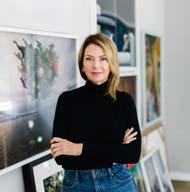

Artsuite is an online platform and art marketplace that’s all about creating connections. By organizing virtual exhibitions and unexpected collaborations, activating non-traditional spaces, offering art advising services and sharing the stories of artists and collectors from around the world, the Artsuite team helps connect you with art that moves you and artists that will inspire you. Founders Marjorie Hodges and Allen Thomas believe that living with art is one of life’s great pleasures, if you are thinking about beginning a contemporary art collection, here are several important tips.
IMMERSE YOURSELF IN ART
Visit museums, galleries, artist studios, art fairs and attend art programs whenever you can. You’ll be rewarded with creative stimulation and valuable interactions artists and fellow art enthusiasts. Be sure to look carefully at everything, even art that you believe is not your style. Through this process, you will begin to better understand your own tastes and preferences and the various media of art. Over time, you will begin to recognize artistic excellence and develop discernment skills.
Written

38
By Marjorie Hodges
Photo provided by Lisett Kruusimäe (pexels)
North Carolina has many important museums and universities across the state, as well as a robust artist community. If possible, become a member or attend free programs and sign up for curator tours to learn more. Listed below are some of the top museums in North Carolina.
North Carolina Museum of Art, The Nasher Museum of Art, Harvey B. Gantt Center for African-American Arts + Culture, CAM Raleigh, the Mint Museum, the Gregg Museum of Art and Design, Cameron Art Museum, GreenHill Center for North Carolina Art, Ackland Art Museum, Bechtler Museum of Modern Art, Weatherspoon Art Museum, Southeastern Center for Contemporary Art, Black Mountain College Museum and Arts Center, Asheville Art Museum, Reynolda House Museum of American Art, Greenville Museum of Art,
EDUCATE YOURSELF
Before you begin acquiring art, take some time to do your research. Explore the styles of art that appeal to you and learn more about the various arts media—painting, sculpture, photography, drawing, video and more. Spend time on gallery and artist websites and follow your favorite artists on Instagram. Follow art platforms, some of my favorites are @Artsy, @Artistaday @Artnet @Artsuite @Artnewspaper.official @hyperallergic @blackartinamerica @investinherart. There are many other platforms and online resources, as well as a recent book about the art of North Carolina—The Art of the State by Liza Roberts
GET TO KNOW GALLERISTS, CURATORS, ART ADVISORS AND ARTISTS
Building relationships with people you trust in the art community is tremendously helpful in navigating the many art purchase options. These individuals can support your art collecting journey by providing access and important information about an artist’s trajectory, creative process and more. If you are interested in collecting museum-quality works for investment, this is especially important. When artists are on the rise, with significant upcoming museum exhibitions, it can become difficult to acquire works because of increased demand. There are many qualified gallerists, curators, and advisors across the
state of North Carolina. Many are colleagues and friends and would be eager to assist. Artists are inspiring. Getting to know artists in your community is a great way to engage and learn more about art.
TAKE YOUR TIME
When building a collection, it is wise to take your time. Begin acquiring art after you have done your research and have identified artists and styles that you connect with. With a focus on quality over quantity. secure anchor works of art for your collection or your home. Remember there is no need to fill every wall. Sometimes one dramatic or thought-provoking work of art in a room can have a tremendous impact. Slowly build a collection over time. Explore both beautiful works of art by skilled artists, as well as more complex conceptual works.
COLLECT ART THAT INSPIRES YOU
This is the most important tip. Acquire works of art that you love and works that you connect with in a special way. If you are buying art for your home, it is important for the artwork to inspire you. Although art can be a wise investment, there are no guarantees that any work of art will increase in value, no matter how famous the artist. The value of art is not just in its beauty, but also in its ability to challenge our schemas and preconceptions. Art evokes feelings and has the power to move individuals to social action, influence, entertain and educate. Contemporary art is the art of today and effectively addresses the issues of our time. Thanks to the many artists who are inspiring us.
Best wishes on your collecting journey!
All my best, Marjorie
39
Visit: ARTSUITE.COM
Pierce FREELON
LEADING THE PATHWAY TO AFROFUTURISM: AN INTERVIEW WITH PERFORMING ARTIST PIERCE FREELON
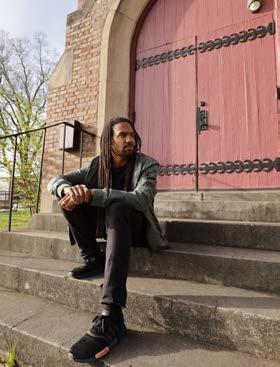
Grammy nominated musician and Emmy Award-winning co-creator of the PBS series the “Beat Making Lab”, Pierce Freelon, has served as an advocate, community activist, and former Durham City Council Member in the Durham community for many years. He is the co-director, writer, and composer for the PBS animated series, “The History of White People in America”, which has caught the attention of the Tribeca Film Festival. His work as a professor, musician, and his creative talents have earned him numerous accolades. He is a founder of Blackspace, an Afrofuturist digital maker space for children that empowers them to dream creatively and explore various forms of art. He is the founder of the children’s boutique media company, Galactic South and he released the album, AnceStars, with his mother, multi-Grammy nominated artist, Nnenna Freelon. This historical release signified the first time a mother and son were nominated for a Grammy during the same Grammys Ceremony.
Written by Kimberly Knight
40
Photography provided by Jonathon Leach
How iconic is that and Freelon has released music and videos centered on honoring African American history, culture, families, and artistry. He released a music single and video dedicated to African American actor, director, and television personality, Levar Burton. His video “Braid My Hair” starring his daughter, Stella Freelon, became an empowering video of showing an African American father and his daughter bonding while enjoying time for self-care. In May 2023, he released a book entitled, Daddy & Me, Side by Side, a children’s book focused on a father and son spending in nature while creating new memories together. However, it’s Freelon’s attention to detail, connection with his art, and community-driven ambition to inspire others to dream, that makes him someone to watch. He’s been featured on major networks and programming such as CNN, MSNBC, Today Show, NPR Morning Edition, and of course Substantial Magazine.

It’s true, Freelon has accomplished many amazing accolades. However, his role as a husband and a father has shined brightly through his talents and you can see
that it is his greatest accomplishment of them all. An accomplishment he was able to share within in his creative works but also in honor of his beloved late father and renowned architect, Phil Freelon. The Substantial Team President, Greg Hedgepeth, had an opportunity for a candid interview with Freelon in honor of the North Carolina Museum of Art exhibition of two-time Oscar-Award winning costume designer, Ruth E. Carter and Freelon’s perspectives on Afrofuturism.
When did you really develop? You mentioned that you’re an artist? When did you really develop a passion for the arts?
I think this world is full of art and so is Durham. I don’t know if you could hear just in the faint distance that train whistle? To me, that’s growing up in Durham.
Hearing the explosions of the fireworks from the Durham Bulls stadium at the end of a Durham Bulls game is music to my ears. Being immersed in nature where you are kind of walking through looking underneath rocks and it was spending time with my dad and
41
PHOTOGRAPHY BY JONATHON LEACH
my siblings in the woods. That is a beautiful landscape. The artist is God and just look at this beautiful creation. A creator made this stuff, right and we as people also have the privilege of creating things. Life is art. Speech and voice is song, Movement is dance, especially as Black folks. I feel like our DNA is laden with creative energies and vibrations. It is one of the reasons why you know, we hear a beat, like it’s just in us. It is tethered to our souls. So, for me, I don’t know a time that I wasn’t living an art-filled creative life. I just found a way to take the practices that felt intuitive, natural, abundant for me, and make money while doing it. That’s really when you become an artist, presumably, when you can sustain yourself in capitalism through the art that you make. That started, I guess, in high school and college when I started doing shows. So, but you know, I guess I would say I’ve always been an artist and now I just get paid to do it.
We’re talking about Afrofuturism and I would like to know how do you get that? How do you know? What is that feeling? What has been challenging in that process?
So that’s three questions. Extraordinary. So, I’ll start with the, you know and so I learned very early in my career, I wear a lot of hats. You look at my Wikipedia page and be like, “Hey, brother, how you do all that?” I
don’t do it all at the same time. I’ve learned through experience that I can only do three things at a time. That’s my limit. Well, let me put it this way, I can only do three things well at a time. Therefore, any one of those things is like a family. You know what I mean? I can’t take on more than three projects simultaneously. My family is so wonderful, graceful, and considerate of my career. You hold it down with the fam for a minute while I go get this work, you know what I mean. She’s able, as a mother, to be able to hold it down for the family. To make sure that kids are cared for and nurtured with the attention of all the things they need. While I go for five weeks in the Dominican Republic to handle this residency that I just wrapped in November. So that that requires, again, a village of folks who can pour into my kids. So, they don’t feel at a loss when I’m doing what I need to do for my spirit, my community, and for breaded for sustenance for our family. So yeah, I know my limits. I think part of it, too, is something my dad taught me, you know, which is to quiet myself if I can. That if I have a serious, conflicting set of opportunities that are all dope, and I need to come to a decision knowing that my limit is like three things. It’s like, what do I need to put down in order so I can pick this up?
Talk to me about the influence of your mother and father, your whole family really. I think I’ve even read
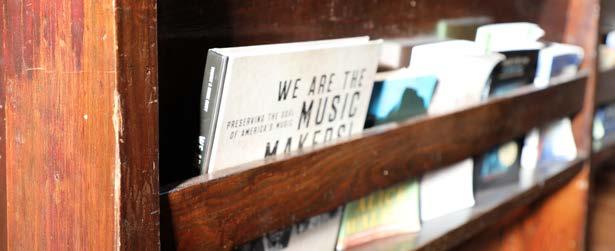
somewhere where it was saying you are the first family of art and creativity in Durham. How did they nurture you to where now you have this clear perspective of your career?
Yeah, it’s really simple. We’re fathers, right? Yes, number one. Love is that simple. You pour love into your kids. They’re gonna be alright, we’re gonna be all right. They’re gonna be all right. That’s the number one ingredient. They love me. They put me in situations with other people who love me who poured into me. You know, I could name dozens. It is cliche, but it is so true, it takes a village to raise a child. Mrs. Mozella Lambert McLaughlin passed away two years ago at 104. You know, it was being at her house and eating her collard greens. You know what I mean? It was running around in her backyard. It was Miz Mc and it was Baba Chuck Davis, it was sister Cydia. You know what I mean? These elders who cared for me and loved on me. Who told me you’re worthy, you’re dope, you’re creative, you can do what you want to do creatively, and be who you want to be professionally. Listen, that’s why I can’t help but mentor other people. Otherwise, you hold on to those blessings and try to hoard them then you’re just going to be soaking wet. The vessel can only hold so much. So, I understand. Just like my parents have people pouring into them until they’re overflowing, I know that my vessel is full. Part of my responsibility is to use that surplus to nourish others around me. That’s other colleagues, other artists, other youth, my own children, my wife, and I need to pour into them. Because not everyone has been blessed with a large vessel or a thirst-quenching abundance of nourishing things to put to drink. You know what I’m saying? Some people out here are parched.
What’s one project you’re most proud of?
This project we just wrapped in the Dominican Republic, making beats and building puppets with girls in the Dominican Republic.
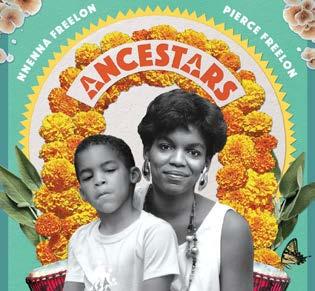
Who’s the most creative in your family?
Most Creative? That has to be tough, are you talking about my immediate family or the family that I came from with my parents and my siblings. The family that I grew up in, I would say my dad was the most creative. In my immediate family, I would say I’m the most creative with my daughter right there in a close second.
If you could collaborate with anyone, who would it be?
Oh, wow, collaborate with anyone who would it be? It would be my mom and I’m doing that right now.
43
VISIT WEARESUBSTANTIAL.COM FOR EXCLUSIVE VIDEO CONTENT. Visit: piercefreelon.com IG: @piercefreelon
NEW CHILDREN’S ALBUM BY PIERCE FREELON & NNENNA FREELON: “ANCESTARS” OUT NOW!
AFROFUTURISM: THE HISTORY, THE ARTS, AND THE CULTURE
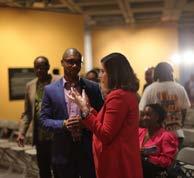
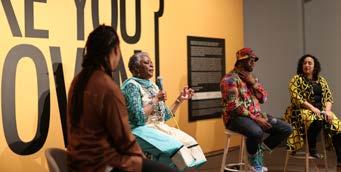
Back in early May Substantial teamed up with the North Carolina Museum of Art along with Grammy-nominated musician Pierce Freelon for a roundtable discussion about the history and future of Afrofuturism, its role in the arts, and its impact on Black culture. Our panelists included Valerie Johnson, dean of arts, sciences, and humanities at Shaw University; Carly Jones, president and CEO of ArtSpace; Fabian Williams, visual artist; and Jalen Jackson, ArtSpace HBCU student in residence.
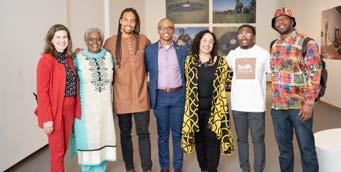
While the conversation centered around defining afrofuturism, it also allowed our audience to explore its rich history, vibrant arts, and profound cultural impact. We shared examples of how, for some time now, we have been drawing inspiration from the African diaspora and envisioning futuristic narratives centered on Black experiences. Afrofuturism is not only a way of looking at the future and alternate realities through a Black cultural lens, it is Black people creating the future as we know and want it to be.
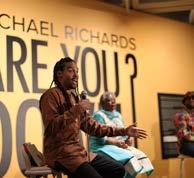
44
A special thank you to the North Carolina Museum of Art for hosting this event and providing free admission to the Ruth E. Cater: Afrofuturism in Costume Design exhibition.
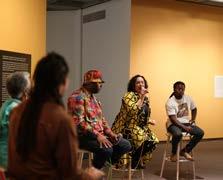

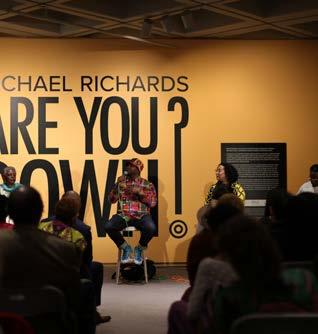
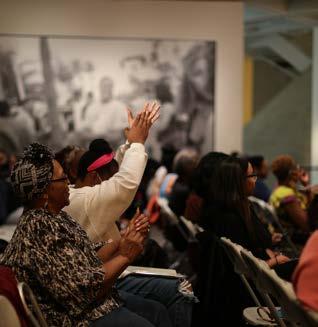
45
Photography provided by Jonathon Leach, Shots by Cash Randy Curtis, 8bitCreatives
EXPLORING NC ART GALLERIES
We’ve curated a list of galleries across the state. While commendable in its efforts to highlight and showcase the vibrant artistic spaces within North Carolina, this curated list should not be perceived as an exhaustive representation of the sheer number of exceptional galleries in the region.. North Carolina boasts a rich and diverse artistic landscape, encompassing a multitude of galleries, each with its unique style, history, and contribution to the cultural fabric of the state. The list provided below serves as a valuable resource for discovering and supporting Black-owned and Black-centered galleries, yet it is crucial to acknowledge that there are numerous other outstanding galleries that may not have been included. We encourage you to explore further and engage with the broader artistic community of North Carolina to fully appreciate the depth and breadth of the remarkable gallery spaces in the area. Visit wearesubstantial.com and tell us about other galleries in our state.
African American Atelier 200 N Davie St #14, Greensboro, NC 27401 africanamericanatelier.org
Bennett College Steele Hall Gallery 900 E. Washington St, Greensboro, NC 27401
BlkMrktClt
1824 Statesville Ave, Charlotte, NC 28206 blkmrktclt.com
Black Friday Market 23 W Hargett St, Raleigh, NC 27601 blackfriday.market
Black Oak Society blackoaksociety.com
C.S. Brown Cultural Arts Center 513 S Main St, Winton, NC 27986 csbrownculturalartscenter.weebly.com
Cameron Art Museum
Minnie Evans Study Center 555 Halyburton Memorial Pkwy, Wilmington, NC 28412 sites.google.com/nhcs.net/meac
Delta Arts Center 2611 New Walkertown Rd, Winston-Salem, NC 27101 deltaartscenter.org
Drinking Gourd Gallery dggallerync.com
Dupp & Swat
1824 Statesville Ave, Ste 105 Charlotte, NC 28206 duppandswat.com
Elizabeth City State University
Mickey L. Burnim Fine Arts Center 1704 Weeksville Road Elizabeth City, NC 27909 ecsu.edu
Harvey B. Gantt Center 551 S Tryon St, Charlotte, NC 28202 ganttcenter.org
Hayti Heritage Center 804 Old Fayetteville St, Durham, NC 27701 hayti.org
Ledonia Wright Cultural Center East Carolina University 501 E 10th St Greenville, NC 27858 lwcc.ecu.edu
Maimy Etta Black Fine Arts Museum and Historical Society 404 Hardin Rd. Forest City, NC 28043
North Carolina Asociation of Black Storytellers ncabstellers.org
North Carolina Central University Art Museum 1801 Fayetteville St, Durham, NC 27707 nccu.edu/nccu-art-museum
NC A&T State University
H.C. Taylor Gallery and the Mattye Reed Gallery 202 University Circle (Dudley Building) Greensboro, N.C. 27411
NC State University
The African American Cultural Center Art Gallery 2810 Cates Ave Raleigh, NC 27606 diversity.ncsu.edu/aacc/gallery
Noir Collective AVL 39 S Market St c, Asheville, NC 28801 noircollectiveavlllc.business.site
NorthStar Church of the Arts 220 W Geer St, Durham, NC 27701 northstardurham.com
Pop Box Gallery 304 S Driver Street, Ste 102, Durham, NC 27703 popboxgallery.com
Real African Art Gallery 440 E McCullough Dr Ste A-111, Charlotte, NC 28262 realafricanart.com
Studio 229 on Brevard
One Story, 229 S Brevard St, Charlotte, NC 28202 studio229onbrevard.com
Triangle Cultural Art Gallery
8320 Litchford Rd Suite #138, Raleigh, NC 27615 triangleculturalart.com
Winston-Salem State University
The Diggs Gallery
601 S Martin Luther King Jr Dr, Winston-Salem, NC 27110 wssu.edu
YMI Cultural Center 39 S Market St, Asheville, NC 28801 ymiculturalcenter.org
311 Art Gallery 311 W Martin St, Raleigh, NC 27601 311artgallery.com
46


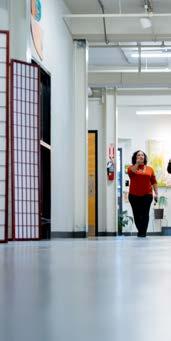




A Substantial THANK YOU to all our featured artists and to the number of Black creatives that helped us bring this issue to life. Together with the help of the North Carolina Museum of Art, our talented pool of freelance writers, photographers, videographers and creatives, we truly hope we’ve created something special.
There is an enormous amount of talent here in North Carolina and we know we barely scratched the surface.
We are Substantial and so is our Art, Culture and Community!
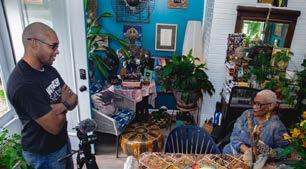

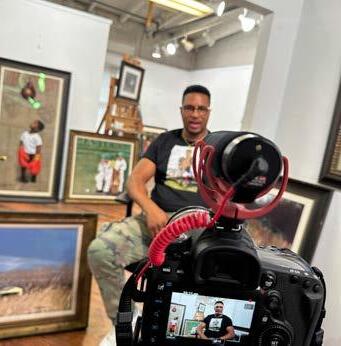

49
WE ARE
of considerable importance, size and worth. Strongly built and made.
wearesubstantial.com






















 Written by Joelle Adeleke Photography By Jonathon Leach
Written by Joelle Adeleke Photography By Jonathon Leach


 Written by Greg H.
Written by Greg H.




 PHOTOGRAPHY BY TREY JOYNER
PHOTOGRAPHY BY TREY JOYNER













































